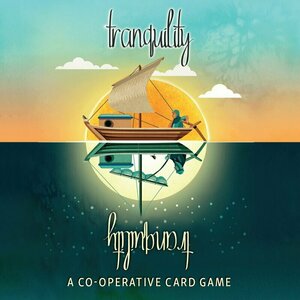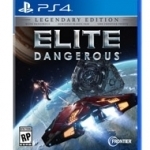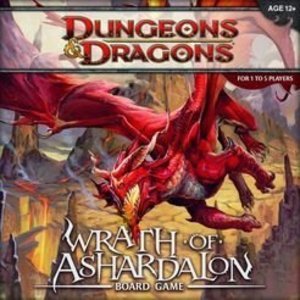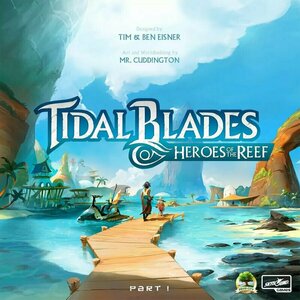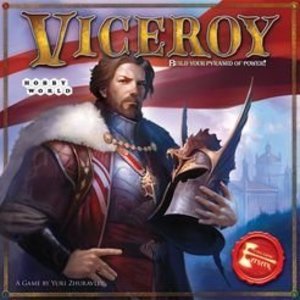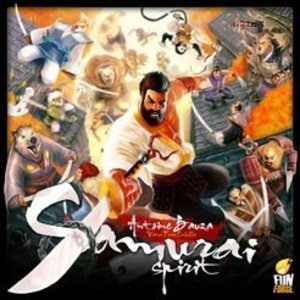Purple Phoenix Games (2266 KP) rated Tranquility in Tabletop Games
Oct 21, 2021
Tranquility is a cooperative hand management, tile placement card game for one to five players. In it players will be attempting to create a sea of islands around which they sail their boat towards infinite paradise. They will accomplish this by laying numbered cards from their hand in numerical order before any of the players run out of chances to play a card. Oh, and there’s also no talking during the game. That’s kind of a big deal.
DISCLAIMER: We were provided a copy of this game for the purposes of this review. This is a retail copy of the game, so what you see in these photos is exactly what would be received in your box. I do not intend to cover every single rule included in the rulebook, but will describe the overall game flow and major rule set so that our readers may get a sense of how the game plays. For more in depth rules, you may purchase a copy online or from your FLGS. -T
To setup the standard game, place all the border cards around a 6×6 grid, as in the photo below. Shuffle the appropriate number of Start and Finish cards into the deck of Island cards and place that beside the grid. Draw a hand of five cards and the game may begin. Setup is similar to the multiplayer setup, with a few changes. Once the hand of cards has been drawn, the game may begin! It is the solo player’s goal to build the sea of island cards, and place the Start and Finish cards before they run out of cards to be legally played.
The game is played over many turns. Each turn players will be either playing a card from hand or discarding two cards. When a player plays a card from hand to the grid, they may place it anywhere they wish within the grid. The goal is to have each card placed numerically in order beginning from the lower left of the grid in a zig-zag pattern left to right, then ascending to the next highest level. In other words, the play area would be ordered numerically as English-speaking people read, but from the bottom up instead of the top down – like a reverse typewriter.
When a card is played, the player may choose to place it in its own area, or immediately next to another card already in play. If the new card is placed adjacent to an existing card, the player must discard cards equal to the difference between the values of the two adjacent cards. For example, if a 12 is placed next to a 14, then the player would need to discard two cards after placement. If a card is placed that is already in direct numerical order, no discards are needed. Again, a card at the right-hand edge of a row is adjacent to the card on the next row higher on the left-hand edge, and this is the most difficult aspect of the game to grasp for new players.
Should a player instead wish to discard two cards for their turn, they do so to their discard pile. After each action (playing a card or discarding two cards) the player will draw back up to their hand of five cards.
Eventually, the player will happen across the Start and Finish cards. In the solo game, when a Start card is placed (outside the grid, but in amongst the border cards in the lower left-hand corner), the player will need to draw eight cards from the draw deck, keep four, and discard the remaining eight. This eats up cards from the draw pile and draws the game closer to the end. When the grid is completed and all the numbered cards are in numerical order, the player may then play the Finish card to end the game. If all cards are properly placed the player wins! If not, they must try again. Probably immediately, because it is that kind of game.
Components. This game is a bunch of square cards in a cubic box. Now, while that doesn’t sound super exciting, the art on the cards certainly make up for the lack of component diversity. Each card is matte finished, which I prefer for cards with great art on them. And oh man, that art is something wonderful! I have always been a fan of Tristam Rossin’s art, and it is on full display here. The cards are, well, I guess I cannot find the correct word because they aren’t double-sided, but split on the horizontal, with a daytime scene on the “top” and a nighttime scene on the “bottom” (or vice-versa, however you feel). I have nothing but praise for the components here.
The gameplay is familiar in feel, but definitely a little different and a whole lot of fun. Fans of The Mind will find this familiar in that the game is structured around silent players building a grid/stack of numerically appropriate cards until the win condition is met. However, I have not been able to play The Mind solo, and Tranquility comes with solo rules in the box. So that’s a win in my book.
Now, Tranquility solo is no cakewalk. No, there are no other players to make crazy decisions to throw off any tactics planned, but you most certainly can misjudge where to place a card, and then be married to its position as you try to fill in all the appropriate cards around it. I learned that all too early when I decided my first game that I should try to divide the grid into equal sections and approximate where a 48 should go. Well, I’ll tell you now that a 48 has absolutely no business being a row above a 19 (check the photo above if you don’t believe me). Silly choices like this make for an afternoon of pondering optimal placements when unboxing your next play, and that brings a smile to my face. Any time I think about a game the next day or several days later and it entices me to play again with a different strategy, I feel is the mark of a great game.
I have yet to play this with a group (damn COVID), but I know the people I play with are going to love this one. And, honestly, I am going to love the peace and quiet as the game plays out, so I can think about my turn and then think about a different possibility once someone ruins my plans. But I tell you what, even as a solo game, this one is great. I am quite happy to keep this as a pure solo experience, but I do want to try it once with others. We do not typically give out ratings for Solo Chronicles reviews, but this one would be pretty high, I’m telling you now. Okay, I have to go get the boat ready and pack my cooler. Enjoy Tranquility!
GameCritics (290 KP) rated Elite Dangerous Legendary Edition in Video Games
Aug 11, 2017
Original Score : 9 out of 10
Read Review: http://www.playstationlifestyle.net/2017/07/04/elite-dangerous-review-galactic-conquest-ps4/#/slide/1
Grumpy Goblin (123 KP) rated Dungeons & Dragons: Wrath of Ashardalon Board Game in Tabletop Games
Mar 27, 2018
I am a D&D fan, so was quite looking forward to playing this, the packaging and content of the game really caught my attention when the game arrived, I was definitely very excited to start playing.
I read through the rules fairly quickly and set the game up ready to play, the first run through was OK although I messed up the rules a little and felt it would be better to start again, after a quick re-read I was ready to go again. Just bare in mind, the rules are easy, but there are a few things you end up forgetting, so it is handy to read them through a couple of times and have them handy when playing.
I carried on through the game a little longer and soon realised it was quite a tedious process, as I was playing on my own and not with others the game needed to keep me entertained, and it really didn't do that.. I was actually starting to wish it would end (I am someone who has to finish a game and can't stop half way through) and when I finally died, I was actually quite relieved.
I ended up putting it away and not coming back to it for a while.. until one day when a couple of friends were over and we weren't in the mood for a really intense style game, I decided to pull it out and see how it played with others. It was certainly a much different experience, it seemed to flow better and just having the others there to have a bit of fun with definitely made the game much more enjoyable.
I would say it is worth buying the game to play with your friends but as a solo game, I really wouldn't bother.
Purple Phoenix Games (2266 KP) rated Tidal Blades; Heroes of the Reef in Tabletop Games
Apr 20, 2021
DISCLAIMER: As this game is a giant and many reviewers are starting to tackle it using multiplayer rules, I decided I would talk about the differences between multiplayer and solo rules. This review is using the included Solo Mode rules.
Setup for the Solo Mode uses most of the setup rules for the multiplayer game with a few exceptions. In the Solo Mode the player will have one character to control and one Rival to beat. The Rival will need their player board and standee or mini (I have the Deluxe Edition, so it’s minis in my case). In addition, the player will also choose two other characters to be Allies, utilizing their ability cards and minis. The Allies and Rival will be placed on the Champion board ahead of the player to begin the game. The player wins by having more points than the Rival at the end of the game.
Quickly, here is Tidal Blades in a nutshell. Players are attempting to gather the greatest standing on the Champion board (like a VP track) and VP from Challenge cards gained. The players earn these cards by using Actions to move to islands, gather resources, fight monsters, perform boating maneuvers and tricks, and can increase the potential for each of these by upgrading their central board dials. Shells and Fruit are common resources, and each player starts with two Actions per turn. The game lasts four total Days (or phases with several turns in each), and players earn more Action discs on Day two and four. Every time the dice are rolled to complete Challenges a Danger Die is also rolled and can wound the player by forcing a discard of dice. Each Day players can refresh and upgrade used dice to better their skill and concentrate their abilities. After Day four the game ends and players count up points to declare a victor!
Here is how gameplay is slightly different from the multiplayer experience. The Rival always goes first. They will also have one more Action disc to use on their turn (unfair, right?). When they begin their turn, a Challenge card is drawn. Whichever Island is featured on the card is to where the Rival will travel. Once arrived, the amount of VP awarded on the card is how many spaces from the top of the Island the Rival will be placed. Depending upon which Island the Rival ends the Challenge card will then be placed under the Solo Mode mat and a special action taken. The special actions could be revealing and resolving a Plot card in Droska Ring (special to Solo Mode), removing Monster hits from the Fold in the Chronosseum, or moving the boat in Lamara Stadium. The Judge location also plays a role in special actions should the Rival land on the same Island as they are. Other special goodies await, but I will leave you to discover those.
On the player’s turn, if the player is tied with or ahead of their Allies on the Champion board, the player will be able to use the Allies on their turn. This is handled similar to having an extra Action disc on the player’s turn. Send the Ally to a location and reap the rewards. Otherwise, for the player, turns are the same.
Components. Let me tell you: if you have the extra money to splurge for the Deluxe Edition, DO IT. The minis are amazing, the plastic shells are awesome, and those squishy fruit are so perfect! Obviously the game is perfectly playable and enjoyable with the basic components, but the improved bits are really something special. The cardboard everything is great, the GameTrayz inserts are incredible, and the art and colors are simply magical. I cannot say enough excellent things about what comes in this massive box. Druid City Games and Skybound Tabletop got everything right with this one.
It should be no surprise that I am in love with this game. Yes, it’s a Solo Chronicles, and I played by myself. I get that. Eventually I will be able to play this with others and by then I will be so engrossed in the lore that I will have no problems hyping up my playmates. Tidal Blades is an absolutely gorgeous game with so much going on that I don’t think I will ever tire of it. The game lasts four days but I wish it were a month because I just want to keep playing! The decisions to be made are all wonderfully delicious and there always seems to be too few on your turn. Yes, I know that sounds like all worker placement games, but it is especially true here. Almost every spot on the board gives immediate benefits that can be used, so even when a location is occupied, there will always be another of equal importance to your character. It’s so good.
Like I said before, I love the art and colors used. This is a stunner of a game on the table. It does take up quite a bit of room, especially if you use the arena dice tray (which I didn’t because I play at night when the kids are asleep and a hard plastic dice tray wakes up children). I count myself lucky to have the Deluxe Edition as well because those upgraded bits really make the game feel deluxe and fancy.
The Solo Mode is very good, and at least for me, very difficult to win. The combination I used for this review was playing as Axl against my Rival Caiman. Obviously switching out characters and using different Allies will change up the feel a bit, and I really cannot wait to try out all the permutations. When a game begs you to play it as often as you can and you look at it lovingly on your shelf, you know you have a Top 10 game, and a treasure in your collection.
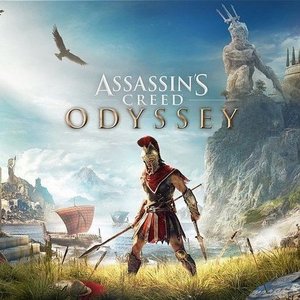
Assassin's Creed: Odyssey
Video Game Watch
Set during the Peloponnesian War, an ancient conflict between Athens and Sparta that was a crucial...

Red Dead Redemption 2
Video Game Watch
Developed by the creators of Grand Theft Auto V and Red Dead Redemption, Red Dead Redemption 2 is an...
Western
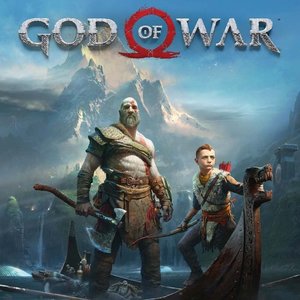
God of War
Video Game Watch
His vengeance against the gods of Olympus far behind him, Kratos now lives as a man in the lands of...
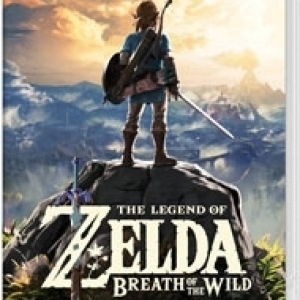
The Legend of Zelda: Breath of the Wild
Video Game Watch
Amnesiac protagonist Link awakens from a hundred-year slumber to a mysterious voice that guides him...
Zelda Nintendo Open-World Story

Horizon Zero Dawn
Video Game Watch
Explore a vibrant world rich with the beauty of nature – but inhabited by awe-inspiring, highly...
Horizon: Zero Dawn
and 5 other items
Purple Phoenix Games (2266 KP) rated Viceroy in Tabletop Games
Jun 12, 2019
Power. That’s what everyone wants, isn’t it? Well, at least it is in Viceroy! As an inhabitant of the world of Laar, you are fighting to become the ultimate ruler. Recruit allies who provide strategic advantages and enact laws that solidify your claim for power. Do you have what it takes to build and maintain a powerful kingdom, or will your attempts fall short?
DISCLAIMER: There is an expansion to this game, but we are not reviewing it at this time. Should we review it in the future we will either update this review or post a link to the new material here. -T
Viceroy, a game of card drafting and tile placement, is played over 12 turns in which players build a pyramid with their cards – paying to place each card and collecting rewards based upon which level of the pyramid a card is placed. Each turn is divided into two phases: Auction and Development. During the Auction Phase, players bid gemstones to buy a card from the auction line. Once every player has either collected 1 card from auction or passed, play moves to the Development Phase. During the Development Phase, players can either play a card into their pyramid, pass, or discard a card and take 2 gemstones from the reserve. To play a Law card into your pyramid, you place it for free. To play a Character card into your pyramid, you have to pay for it with gems. The cost is dependent upon which level of the pyramid the card is to be placed. You must pay for the level the card will sit on, as well as pay the cost for every level beneath it. For example, to add a card to the third level of the pyramid, you must pay the cost for the 3rd level, AND 2nd level, AND 1st level. The rewards gained from adding a card to the pyramid, however, are taken only for the level on which the card sits. In the earlier example, you would only get the reward for the third level alone, since that is the level on which the card sits. The Development Phase is played over 3 rounds, so a player could play up to 3 cards into their pyramid during 1 Development Phase. After the 3 rounds are up, the next turn begins again in the Auction Phase. When all cards are gone from the Auction Deck, the game ends. Players count up all of their Power Points, and the player with the highest Power value wins!
The only change in Viceroy between a group and solo game is during the Auction Phase. Obviously, if you are playing solo, there is nobody to bid against for cards. How that is alleviated is that you still bid your gemstone as normal, and you randomly draw an unused gemstone from the box as an AI bid. If the colors match, you lose your gem and go on to the next auction. If the colors do not match, you collect your choice card, and the card the AI would have collected gets discarded. If the AI color does not match an available card, you just discard one of the remaining cards. This mimics group play in the sense that you might not always get the card you want from auction! The Development Phase is played as normal. At the end of the game, count points as normal and try to beat your own high score.
Viceroy is a neat game. Every card has so many options that there is no one single strategy that is a sure-win every time. Maybe one game I’ll go for Magic tokens. And maybe the next I’ll try to go for raw Power Point tokens. The possibilities really are endless, and that keeps this game fresh for me. I don’t feel like I’m just going through the motions because every card will act differently depending on where it is played. Strategy really is everything here. On the flip-side of that, however, is that sometimes the options can be a little overwhelming. With so many possibilities for each card, it can get hard for me to decide on what strategy I really want to use. It should also be noted that a card can only be played onto a level if it can sit on exactly 2 cards on the level beneath it. So sometimes I buy a card to play on a certain level only to get to the Development Phase and realize I don’t have a legal place to which I can play it. So do I sacrifice other cards/gemstones to build a slot for this one card, or do I play it to a different level and change my strategy a bit? There’s a little bit of a learning curve, but the more I play, the better I get (or at least, the better I think I get).
Another grievance with Viceroy is that I find myself running out of cards in my hand a lot. The only opportunity to draw cards is if you play a card into your pyramid that allows you to do so. And since I’m usually focused on other strategic routes, I don’t use those cards for those purposes. So then I play all of the cards in my hand (leaving me empty-handed), get 1 card at the next auction, play it, and am again left with no cards in my hand. To fix this issue, I wish one of the actions you could take during the Development Phase was to draw 1 card. I’m not sure if other people have this issue, or if it’s just me, but it’s a problem I run into almost every game.
Overall, I think Viceroy is a good game. It’s unique in the sense that there are so many possibilities that you’ll probably never play the same game twice, even if you decide to play by the same strategy. The mechanics and gameplay are cool too – it’s fun to watch your pyramid literally grow in front of you as the game progresses. This game takes a little more focus and thought than you might think, so it’s not one I’d necessarily just pull out for some light fun. I think Viceroy is as exciting as a solo game as it is as a group game since there really aren’t any differences between the two settings. If you like Viceroy, give it a try solo! If you’ve never played Viceroy, try it either solo or in a group – it’s the same game after all!
https://purplephoenixgames.wordpress.com/2019/04/18/solo-chronicles-viceroy/
Gareth von Kallenbach (980 KP) rated the PC version of Battlefield V in Video Games
Jun 19, 2019
The solo portion of the game has players battle in some diverse locales and focuses on situations form history where the participants were not well known and did not receive much glory or attention for their deeds.
After the introduction, players have the following options as described by E.A.
The stories were very enjoyable and thought provoking though I did get a few bugs while playing like a cut-scene lock up and some clipping issues where enemy characters were lodged in walls. Thankfully issues like this were few and I was able to complete the missions as they were engrossing and kept me riveted throughout.
I especially liked the Nordlys mission where I was able to don Skis and made my way around the frozen landscapes to complete my mission.
The missions were a mix of stealth, surviving waves of enemies, and capturing objectives which is what you would expect for a game of this type. The game does allow players to have a more diverse approach to completing missions as you can use vehicles and other objects found in the game to be creative. I was able to “borrow” a plane in Under No Flag to strafe the enemy locales. When my piloting skills were not up to snuff and I crashed in a lake; I redid the mission from a direct assault approach and things went much better for me.
The game uses a regenerative health system so should you take too much damage, simply take cover until you heal up and battle on. There is also an option to heal from time to time when battling online. Players will be able to pick up new weapons and ammunition off fallen enemies as well as at various points throughout the game.
Visually the game is very appealing from the open desert to the raging blizzard in the campaigns; there is plenty of eye candy to enjoy along with the action.
The online modes were very enjoyable as there were a variety of modes for players to enjoy.
The multiplay was good and what impressed me was how fair the hit detection was. You did not have to empty an entire clip into an enemy to take them down nor did glancing shots also produce a fatal result. The maps were large and highly detailed which allowed players to try a mixture of gameplay styles to best suit their needs.
It should be noted that additional content for the game will be coming as the menus made mention of solo missions and other features that were listed as “coming soon” and we know that the Battle Royale mode for the game is not due until 2019 as an example.
It should also be noted that I did not see the Female fighter with the prosthetic arm that was featured in the announcement trailers for the game and caused division amongst fans upon the reveal for the game. If she was edited out, planned for a later date, or simply included for demonstration purposes remains to be seen. What is clear is that although fans may expect more content and be disappointed in having to wait for parts of the game to release at a later date, the game is enjoyable for fans of the series and after my experiences with the Beta; even better than expected. I look forward to seeing what the game will look like in the future once the coming updates and patches are applied, but for now; Battlefield V is a solid WW2 game with solid visuals and sound and is a worthy entry into the series.
http://sknr.net/2018/11/12/battlefield-v/
Purple Phoenix Games (2266 KP) rated Samurai Spirit in Tabletop Games
Jun 12, 2019
As a Samurai, you spend your life traveling across the land to help those in need. Most recently, you and a handful of other Samurai have been contracted by a small village to defend them against a clan of invading raiders. Only by working together, and by using your extensive training, will you succeed in keeping this village safe!
Samurai Spirit is a cooperative game of press-your-luck. Players take on the role of a Samurai, each with a unique power, and take turns drawing cards and fighting off the invaders or offering support to your fellow Samurai. Invaders can have recurring negative effects, so strategize wisely on how best to combat them and see how far you can push your luck each round. If you are able to survive through 3 rounds (waves) of invaders with at least one surviving farmstead and family, the Samurai are victorious and the village is saved! If any of the Samurai are killed, or the village has been completely destroyed by invaders, then the game is lost. As a solo game, Samurai Spirit plays essentially the same as in group play, with only 2 main differences – the solo player controls 2 Samurai instead of 1, and the support tokens from the unused Samurai are each available for use once during the game.
For such a neat theme, this game falls short for me. It seems simple enough, but there are areas of ambiguity in the rules that lead to some confusion. For starters, the text size is so small that I am not able to find any information at a quick glance! The text itself is not always clear either – like when, at the end of a round, the rules say to collect all cards used this round, does that include cards that have been discarded due to Samurai abilities? How about the cards of the Intruder stack that are presumably discarded after being revealed? The rulebook offers no clarification, and I honestly still don’t know the right answer.
The order/layout of the rules feels mismatched too – relevant information is not always grouped together, and I find myself flipping between several pages at a time trying to figure out one single thing. For example, in the ‘Fight’ action description, it says that if you reach your Kiai value exactly, you can activate your Kiai ability. You have to turn the page to a different section to see exactly what activating that ability means, and then you have to flip an additional 2 more pages to see what each individual Kiai ability is! Why not just put them all in one place? It would certainly be easier to understand if all relevant information was grouped together.
The prominent mechanic of Samurai Spirit is press-your-luck, and I would definitely say that this game is very luck-based. When setting up the game, the initial deck of cards is randomly selected and that can impact whether or not you are able to complete certain requirements each round – if there aren’t enough hat/farm/doll cards for each Samurai, you are guaranteed to incur a penalty at the end of every round. Actual gameplay is very luck-based too, and for me it feels like there are no good ways to strategize – your choices are all dependent on the luck of the draw. You can push your luck to draw more cards and use special abilities, but since you are suffering from recurring penalties each turn, it feels futile to keep going at a certain point.
For me, Samurai Spirit is repetitive and kind of boring – suffer penalty, draw card, and repeat until you eventually pass or the deck runs out. It’s like a too-complicated version of blackjack in which the deck is stacked against you. It’s such a bummer because the theme and artwork are neat, and the gameplay (in theory, at least) should be effective. But the actual execution is too reliant on luck to be successful.
I do quite a bit of solo gaming, but this game is never one that I willingly decide to play. I honestly only broke it out recently as a refresher for this review. Perhaps it is better at higher player counts, but since that is not where most of my gaming occurs, Samurai Spirit is a dud for me.
https://purplephoenixgames.wordpress.com/2019/02/06/solo-chronicles-samurai-spirit/
Purple Phoenix Games (2266 KP) rated It's a Wonderful World in Tabletop Games
Oct 30, 2021
It’s a Wonderful World is a card drafting, economic, civilization building game with variable player powers (with a dash of campaign mode sprinkled on top). In it, players are attempting to build their civilization faster and better than their competitors. However, for this review, I will be playing the vanilla non-scenario solo mode.
DISCLAIMER: I was able to play this and several other games at The Table in Cookeville, TN. If you are ever in the neighborhood, check them out, and tell Nathaniel that I say hello.
To setup, put together the main board and place the round marker on Round 1. Lay out all the resources on their specific places upon the board and shuffle the deck of cards. Deal out eight stacks of five cards each and place them as mini-decks somewhere on the table. Choose a starting civilization (or just randomly choose one). The solo game is ready to play!
Typically, It’s a Wonderful World is a card drafting game, a la 7 Wonders, where players choose one card from the deck passed to them and pass it along to the next player until all cards have been drafted. In the solo mode, however, the player chooses one of the face-down mini-decks as their starting hand. Upon viewing the cards, the player may choose to place any or all of them in their Construction Area, or discard the cards for their Recycle Bonus (typically a type of resource), and/or discard two card from the mini-deck to draw five cards from the top of the main deck. From these drawn cards, the player may choose one to keep and discard all others. The kept card may be placed into the Construction Area or discarded for its Recycle Bonus resource.
Cards placed in the Construction Area require resources to be earned and placed on them in order to complete its build process. Each round the player will receive resources based on which cards have been built and placed above their starting civ card. Some cards, once completely built, will also offer more VP at game end, or supply a VP modifier.
After the first mini-deck has been played completely, the player will choose a second mini-deck and run through the same process. After this second mini-deck has been completed the round ends and play moves to the next round. Play continues in this fashion until all four rounds have been played (so all eight mini-decks). At game end the player counts up all their VP and compares it to the table in the rulebook to arrive at their final tier. My first game resulted in the rulebook calling me a Rooky. So be prepared to be humiliated by a rulebook.
Components. Aside from being bamboozled by the aggressive artwork on the cover, this is not a wargame. In fact, I very much like the artwork and the styling of this game. The cards are all laid out very well, and the iconography makes sense. The resource cubes are translucent colored (except the grayish white is opaque) and are fine quality. Overall the components are great and the art style has grown on me quite a bit.
I can see why so many people compare this to 7 Wonders. Essentially, the multiplayer game is quite similar. Card drafts (of 7 cards, no less) lead to needing resources in order to build, lead to being able to produce more resources to fuel other cards, and bonus points are awarded for having a nice card profile. Now, this being a solo review, I have to say that I much prefer It’s a Wonderful World to its forefather 7 Wonders because it comes packaged with a solo mode already in the box. This isn’t the only reason I prefer it, though. I find it easier to pick up and easier to teach to beginning gamers. Also, there is no card chaining, which seems to be a difficult concept for newer gamers to grasp initially. It’s a Wonderful World has nothing like this, and cards just work. 7 Wonders has been such a hit with my family, and I know they will greatly appreciate a more streamlined game experience with this one.
So here’s my recommendation with this one. If you are a fan of 7 Wonders but find it to be difficult to get others into it, check out It’s a Wonderful World. I feel that it is superior in many ways, and the solo mode is just icing. The solo mode gives me a great play experience, even though I typically am not a fan of games challenging you to beat your own high score. I will live with it here because the game is just so enjoyable. While 7 Wonders was my favorite game of all time for quite a while, it has since dropped out of my Top 10, and I think will be replaced entirely by It’s a Wonderful World. If your tastes are similar to mine, then do yourself a big favor and grab a copy of this one right away. It has several expansions out there, and I believe you will fall in love with drafting again. Now, where did I put my Wind Turbines…
Purple Phoenix Games (2266 KP) rated Bandada in Tabletop Games
Jan 19, 2021
In Bandada players are attempting to catch and return birds that have escaped from the local zoo. These birds are attracted to different food morsels (namely black, blue, and yellow dice) and by manipulating the food source players may be able to catch all the right birdies and score tons of points.
DISCLAIMER: We were provided a prototype copy of this game for the purposes of this review. These are preview copy components, and I do not know for sure if the final components will be any different from these shown. Also, it is not my intention to detail every rule in the game, as there are just too many. You are invited to download the rulebook, back the game through the Kickstarter campaign, or through any retailers stocking it after fulfillment. -T
Disclaimer the second: I am previewing this using the Solo Adventure Variant, which uses many of the same rules as the main multiplayer rules with a few twists.
To setup the solo player will roll all 12 dice and sort them by color. Shuffle the bird cards and reveal three cards face-up in a market row. Grab a scoring cube for the score card, and choose which location card to play. Select (randomly or not) a bonus scoring card and the game may begin!
There are other optional variant rules that can be added to the adventure, but I will not be detailing those here.
Turns are divided into two phases: the Drafting phase and the Cleanup phase. During the Drafting phase the player will choose one of the face-up bird cards to be added to their personal bandada, perform the action described on the top of the card, and then add it to their bandada (personal tableau).
After drafting and bandada-ing the player will perform the Cleanup phase by scoring points based on the bird card abilities printed on the bottom, discarding the remaining face-up cards, and then adding three new birds cards to that market row. This phase differs from the multiplayer rules in that birds are scored once added to the bandada in multiplayer and then again during the Cleanup phase. In the solo mode they are scored only once at the end of the Cleanup phase.
The bird cards all have actions printed at the top that will manipulate the food dice in some way. Actions could simply give the birds a specific number of colored dice and adjust the value up or down. Some abilities will have the player flipping the dice to the opposite side, or adjusting multiple dice by splitting a positive or negative value. Of note in this game is that dice values wrap around the die. For example to increase the value of a 6 die it then wraps around to become a value 1. Manipulation of these food dice will make or break the game success, as I found in all my plays.
The game continues in this fashion until after the fourth full round. The player then totals their score on the score card, adds the points from the bonus card chosen at the beginning, and checks for the victory condition on the location card (the rules suggest starting in Africa). If the player has met the victory condition, the trip was a success! If, like me, the player fails to make 35 points in Africa every time, they must play again!
Components. Again, this is a prototype copy of the game, but I have to say that this is a beautiful minimalistic game. It consists of primarily dice and cards. The dice are translucent and good quality, though translucent yellow with white pips can be hard to read at times. The cards are good quality as well and feature breathtaking avian art. It really does look great on the table and doesn’t take up a ton of room, so I have very few negatives here.
Gameplay is super speedy and agonizing for a solo player. Maximizing points on every turn and having to consider specific win conditions makes for a crunchy little card game that takes about 10 minutes to play. It is definitely something I will be reaching for whenever I have a spare 15 minutes. With setup and teardown I am looking at a fulfilling, if not frustrating, card game experience that can be both anxiety-triggering and also quite calming. I was not sure what to expect when I opened the box, but boy am I glad I have this little gem.
If you are in the market for a great little solo game that can also play multiplayer, looks amazing, and is quick to complete, then look no further. If you are an avian aficionado and need your board and card game collection to reflect this, check out Bandada. I need you all to also promise to write me back once you figure out how to succeed in Africa, as I just plum can’t do it. But I am going to keep trying. As I always say, a game that makes you want to play it more is a mark of a great game, and I think a great game comes in this little box.
